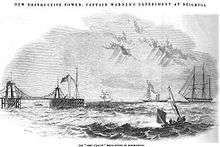Samuel Alfred Warner
Samuel Alfred Warner (c.1793–1853) was an English inventor of naval weapons, now considered a charlatan.[1]
Life
Warner was born at Heathfield, East Sussex, son of William Warner who was a carpenter and reputed smuggler of Faversham. He knew a London chemist called Garrald, and was working with him in 1819 on an explosive. He took service with Pedro I of Brazil in Portugal, and on his return to England found some support from William IV for his claims to have secret weapons.[1]
Warner died in obscure circumstances in the early days of December 1853, and was buried in Brompton cemetery, west London, on the 10th. He left a widow and seven children.[2]
Claimed inventions
From 1830 to the date of his death Warner pressed claims for two inventions. These were the "invisible shell" (reconstructed as a type of high explosive underwater mine), and the "long range", possibly a balloon fitted to drop the "invisible shells" automatically: it emerged eventually that Warner had secretly set up an unsuccessful trial with Charles Green and an unmanned balloon.[1][2] A demonstration of 1841 on a lake in Essex saw a boat blown up, watched by a group including Sir Robert Peel.[1]
Small committees were appointed to examine and experiment on these inventions, but Warner refused to show or in any way explain his secrets till he was assured of the payment of £200,000 for each. In 1842 a committee of Sir Thomas Byam Martin and Sir Howard Douglas questioned Warner. He stated that his father was William Warner, who in 1812 had owned and commanded the Nautilus, hired by the government for covert work in espionage; that he himself had served with his father in the Nautilus, and had, towards the end of the Napoleonic Wars, by means of his invention, destroyed two of the enemy's privateers. There was no verification and the account was marred by anachronisms.[2]
At the same period Warner's claims were assessed by Lieutenant-Colonel Chalmer of the Royal Artillery, and Commander James Crawford Caffin.[3]

A further demonstration in the English Channel off Brighton in 1844 showed a target vessel being towed at sea detonated at a signal. It was well attended, but left unresolved the value of what had been seen.[1]
In 1852 the matter was again brought up in the House of Lords, on 14 May, and a committee was appointed to inquire into it. A week later, on 21 May, the Duke of Wellington intervened, pointing out that the inquiry was one of a scientific nature, and that it had been entrusted to the Ordnance Department. With this the matter appears to have been dropped. The committee never reported.[2]
See Also
Notes
- McConnell, Anita. "Warner, Samuel Alfred". Oxford Dictionary of National Biography (online ed.). Oxford University Press. doi:10.1093/ref:odnb/28767. (Subscription or UK public library membership required.)
- Lee, Sidney, ed. (1899). . Dictionary of National Biography. 59. London: Smith, Elder & Co.
- Morriss, Roger. "Caffin, Sir James Crawford". Oxford Dictionary of National Biography (online ed.). Oxford University Press. doi:10.1093/ref:odnb/4331. (Subscription or UK public library membership required.)
Attribution
![]()